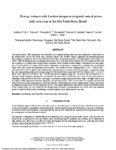Use este identificador para citar ou linkar para este item:
http://www.alice.cnptia.embrapa.br/alice/handle/doc/1001276| Título: | Energy balance with Landsat images in irrigated central pivots with corn crop in the São Paulo State, Brazil. |
| Autoria: | TEIXEIRA, A. H. de C.  HERNANDEZ, F. B. T.   ANDRADE, R. G.   LEIVAS, J. F.   BOLFE, E. L.   |
| Afiliação: | ANTONIO HERIBERTO DE C TEIXEIRA, CNPM; FERNANDO B. T. HERNANDEZ, UNESP; RICARDO GUIMARAES ANDRADE, CNPM; JANICE FREITAS LEIVAS, CNPM; EDSON LUIS BOLFE, CNPM. |
| Ano de publicação: | 2014 |
| Referência: | Proceedings of SPIE, v. 9239, p. 92390O-1 - 92390O-10, 2014. |
| Conteúdo: | The energy balance (EB) components were quantified in a commercial farm with corn crop, irrigated by central pivots, in the Northwestern side of São Paulo state, Southeast Brazil. The SAFER (Simple Algorithm For Evapotranspiration Retrieving) was applied to retrieve the latent heat flux (λE), considering six pivots, covering irrigated areas from 74 to 108 ha. With λE quantified and considering soil heat flux (G) as a fraction of net radiation (Rn), the sensible heat flux (H) was acquired as a residual in the energy balance equation. Seven Landsat satellite images, covering all corn crop stages from 23 April 2010 to 29 August 2010, allowed relating the energy balance components according to the accumulated degree-days (DDac) from the planting to harvest dates. The average Rn values ranging from 5.2 to 7.2 MJ m-2 day-1, represented 30 to 45% of global solar radiation (RG). Considering the variation of the energy balance components along the corn crop growing seasons, the average ranges for λE, H and G were respectively 0.0 to 6.4 MJ m-2 day-1, -1.5 to 6.7 MJ m-2 day-1 and 0.1 to 0.6 MJ m-2 day-1. The fraction of the available energy (Rn - G) used as λE was from 0.0 to 1.3 indicated a good irrigation management, insuring that the water deficit could not be the reason of any yield reduction. Although Rn did not reflected well the crop stages, its partition strongly depended on these stages. λE higher than Rn and the negative H/Rn, happened sometimes along the corn growing seasons. This occurred after the vegetative growth and before the harvest times, indicating heat advection from the surrounding areas to the irrigation pivots, which represented an additional energy source for the evaporative process. The models applied here with only the visible and infrared bands of the Landsat sensor are very useful for the energy balance analyses, considering the size of the corn crop irrigation pivots in Southeast Brazil, when subsidizing a rational irrigation water application in corn crop. |
| Palavras-chave: | Soil heat flux Latent heat flux Net radiation Sensible heat flux |
| ISBN: | 0277-786X |
| Digital Object Identifier: | 10.1117/12.2067090 |
| Notas: | Presented at the 16th Remote Sensing for Agriculture, Ecosystems, and Hydrology. |
| Tipo do material: | Artigo de periódico |
| Acesso: | openAccess |
| Aparece nas coleções: | Artigo em periódico indexado (CNPM)  |
Arquivos associados a este item:
| Arquivo | Descrição | Tamanho | Formato | |
|---|---|---|---|---|
| 4200.pdf | 847,16 kB | Adobe PDF |  Visualizar/Abrir |









